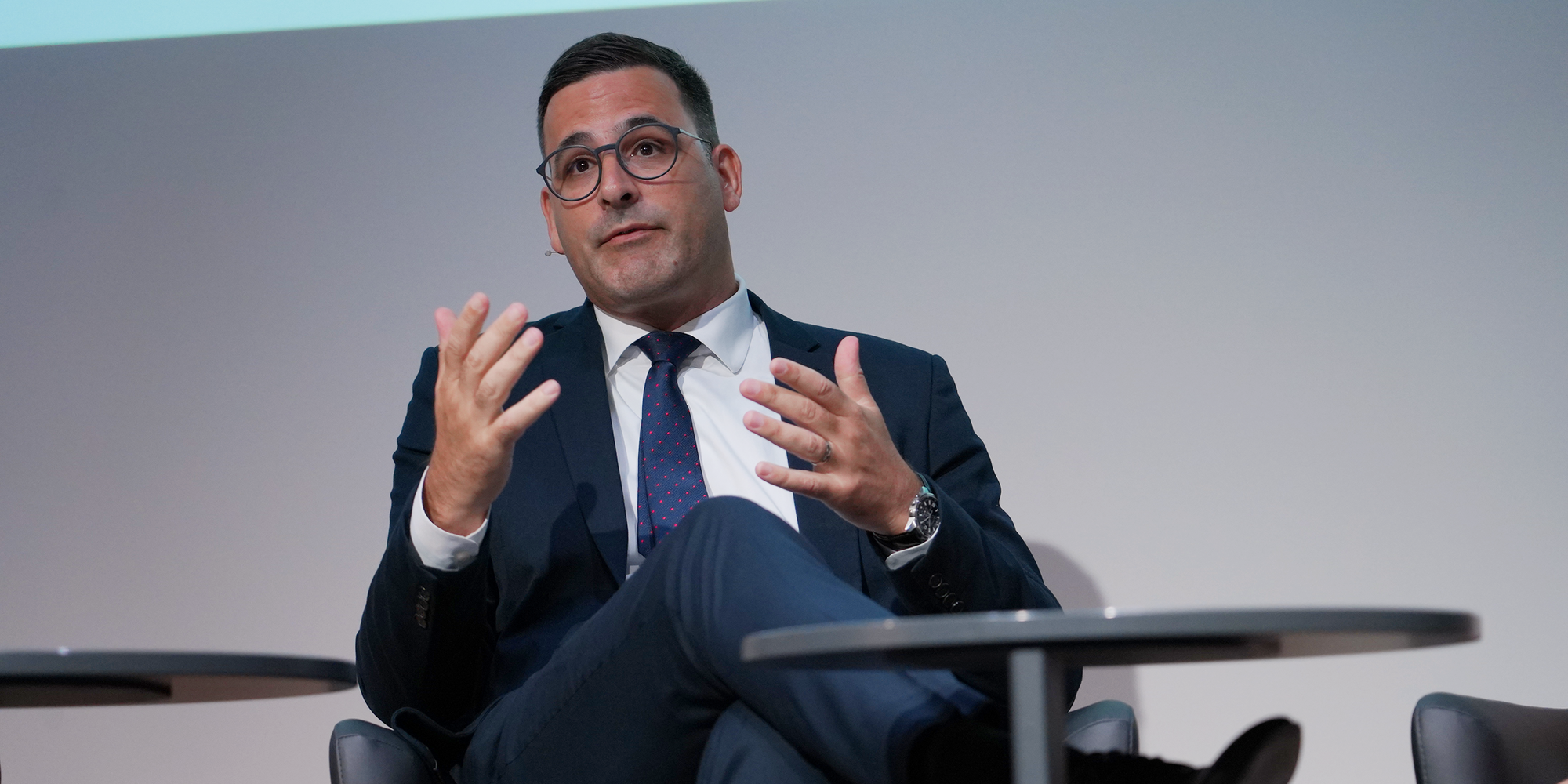"There is often a lack of understanding of the transition"
Fabio Pellizzari, Head of ESG Strategy in Asset Management at Zürcher Kantonalbank, explains the various misunderstandings in sustainable investing, the problems with EU requirements and the power of financial institutions to initiate change.
Interview: Roberto Stefano, Neue Zürcher Zeitung

The most recent climate conference in Sharm El-Sheikh ended almost two weeks ago. What do you remember from this meeting?
Fabio Pellizzari: Nothing that was not already discussed in Glasgow in 2021. No progress has really been made this time.
Are these annual conferences even necessary?
The meetings are essential, even if it is sometimes difficult to agree on concrete measures. Indeed, climate change is a global problem and can only be solved globally. Also, important decisions have been taken at previous UN climate change conferences, namely those in Paris in 2015.
How do these affect your day-to-day business?
The decision of the Paris Climate Change Conference to reduce net greenhouse gas emissions to net zero by 2050, for example, motivated various countries to issue bans on the sale of petrol and diesel cars. As a result, many car manufacturers have announced that they will be phasing out combustion engines. As an asset management company, it is crucial for us to recognise the resulting risks and opportunities for the individual companies. These have a direct impact on the return on a financial investment.
How do you proceed in this context?
We are also committed to the Paris climate targets and have been pursuing a path to greenhouse gas reduction with our active investments in traditional asset classes since 2020. To this end, we measure CO2e emissions in every investment universe. In order to reach the 2-degree target by 2050, we need to reduce greenhouse gas emissions by 4 percent annually. If we strive for the 1.5 degree target, this figure is as high as 7.5 percent per year. We can determine the amount of CO2e emissions for each portfolio on a daily basis. It is also possible to simulate the impact of purchases or sales on the portfolios.
To what extent do you influence companies' sustainability efforts?
We follow the engagement approach, talk to the companies and try to initiate or support appropriate measures. For example, we have been maintaining regular dialogue on greenhouse gas reduction targets with Holcim, probably the largest listed CO2e emitter in Switzerland, since 2017. Another option is to sell some or all of the securities if the reduction target is not achieved. After all, we have to compensate for the CO2e emissions in the portfolio if a company emits more emissions than our reduction path specifies.
Holcim is considered one of the more sustainable cement companies.
That is true. The cement company is working to reduce its greenhouse gas emissions by 7.5 percent annually. It has already initiated numerous measures to this end.
What if Holcim deviates from this path?
Over time, we would have to consider underweighting Holcim stocks in order for the portfolio to meet the carbon reduction path.
You manage the two product lines "Responsible" and "Sustainable". Why is this distinction necessary?
The "Responsible" strategy focuses on the transformation into a sustainable economy and therefore invests in almost all sectors and countries. The strategy goes beyond the blacklist recommended by the Swiss Association for Responsible Investments (SVVK-ASIR). We exclude companies, for example, which manufacture weapons and ammunition, tolerate child labour, produce pornography or operate in the coal industry. We also seek dialogue with companies and strive for the 2-degree climate target.
In the "Sustainable" strategy, the exclusion criteria are even more extensive and the highly ambitious 1.5 degree target is pursued – with the exception of the thematic funds. Here we also invest in business models that already offer solutions for the future today, which will enable them to grow at an above-average rate in view of the social and ecological problems in the coming years. Due to the exclusion criteria and positive selection, around 30 percent of the original investment universe remains. This explains the slightly higher risk of deviation of the "Sustainable" strategy from a traditional benchmark.
Is the "Responsible" strategy actually sustainable?
Yes, absolutely. "Responsible" primarily stands for exclusion criteria and exercising voting rights. We go much further by integrating ESG criteria and incorporating the climate target specifications. There are different approaches to sustainable investing. However, many retail customers have the "Sustainable" concept in mind when talking about sustainability. They are surprised when they find Nestlé or Holcim in the portfolio, for example. Converting existing conventional business models into sustainable business models is very complex, expensive and time-consuming in practice. There is often a lack of understanding of this transition. But it is important that large corporations succeed in the transition. On the one hand, their products are often essential for carrying out the transformation. On the other hand, the effect is also significantly greater if, for example, Nestlé switches completely to recyclable and degradable packaging than if a small organic shop on the corner serves a few customers with a zero-waste concept. Both approaches are justified and benefit society and the environment.
Let's return to the engagement approach, the dialogue with the companies invested in. How effective is this approach?
It is very difficult to demonstrate a direct impact, as we are not the only ones who get involved. In Switzerland, we will certainly be heard more strongly as the third-largest asset manager. Here, we also have very good contacts in the top management of Swiss companies. We have commissioned Sustainalytics to carry out this task abroad. We are also active abroad through co-engagements. All in all, we can achieve a much greater impact today than we could just a few years ago. One successful example of an engagement in which we have been involved is that of Engine Number 1, a small hedge fund. It called for a change in Exxon's Board of Directors towards more sustainability. Thanks to the joint approach of several financial institutions, three established directors were replaced by experts in the field of renewable energies. You can certainly make a difference – not on your own, but together with others.
How do you report transparently to your customers?
Our Swisscanto Sustainability Report shows a number of important key figures for all sustainable funds and compares them with the benchmark index. Besides our own ESG score, we also report on the achievement of the climate target. Controversial business areas are also indicated.
«Responsible» and «Sustainable»
What distinguishes «Responsible» and «Sustainable» funds? Find out the details.
On 1 January 2023, the EU Taxonomy for Sustainable Activities will enter into force. How do you feel about that?
The taxonomy more or less dictates what is sustainable and what is not. The exact rules of the game are still unknown. Of the total of 12 objectives, only two are currently defined. This data will also not be reported by the real economy until 2023. So the whole thing is still a work in progress.
What exactly is the taxonomy?
It currently refers to climate protection requirements for various industries. Further environmental and social goals will follow. For instance, the taxonomy states that a car with less than 50 grams of CO2 emissions per kilometre is considered sustainable, which can currently only be achieved by electric cars. According to the information provided by companies or based on analyses, we as asset managers must show what percentage of our investments is sustainable. For example, if eight percent of a car manufacturer's models sold are below the threshold, then only eight percent of the investment is considered sustainable.
Where is this headed?
The EU taxonomy and the SFDR are unfinished products. It remains to be seen how they will be implemented. In general, we welcome regulation. But it's a very complex topic. This is likely to be a challenge for smaller asset managers in particular – due to the high administrative effort and high costs.
From 2024, the EU also wants to integrate Scope 3 emissions, i.e. greenhouse gas emissions along a company’s value chain, into the sustainability reports for each investment. Does this make sense?
In contrast to direct emissions (Scope 1) and indirect emissions (Scope 2), the data quality for Scope 3 emissions is inadequate. The data is largely estimated. The results therefore differ significantly depending on the data provider. In addition, the Scope 3 data significantly inflates emissions. When coal is burned to generate electricity, emissions occur once. In the Scope 3 calculation, these are now also credited to the mining company, the electricity dealer, the bank financing the electricity generator, etc. But the same source of emissions remains. We take a critical view of simply adding Scope 3 emissions to Scope 1 and 2, because it dilutes previous climate targets that are based on solid data. There are currently no guidelines on how the integration of Scope 3 emissions can be suitably designed.
In that case, is 2024 likely to be unrealistic?
We will try to implement it again next year. But we're not the only asset managers who are at odds with this requirement. As of today, only around 800 companies report Scope 3 emissions. However, around 30,000 companies are in our system alone.
Without sound data and reliable reporting, the suspicion of greenwashing quickly arises. What is your view on this?
The topic is very much in the media, especially after the DWS scandal. If you talk up something that is not implemented, that's greenwashing. I do not think that the financial industry has a systematic problem with this. Rather, sustainable investing is often misunderstood and subjective, as it depends on one's own values. Here's an example: even if a portfolio is clearly stated as being a transition portfolio, the product may be called deceptive if it contains energy companies. In this context, the training of our client advisors is crucial. Simple, comprehensible and reliable communication of the various sustainability approaches, including their suitability for different customer needs, is required.
Your customers include many pension funds and insurance companies. Should their long-term pension funds be invested sustainably?
Pension funds manage around 1 trillion Swiss francs. This is a considerable sum that needs to be invested responsibly. According to the Swisscanto Pension Funds Study, however, they are still cautious with regard to sustainable investment. Only around 40 percent of the large funds measure greenhouse gas emissions, while the figure for smaller pension funds is only 7 percent. So there is still room for improvement.
Given the current global economic situation, to what extent do you see a decline in interest in sustainable investments? Are investments already being reallocated?
No, not at all. Actually, we have measured very high inflows in our sustainable products. This is also consistent with the IFZ study: while traditional funds had to record outflows last year, sustainable investment vehicles recorded a constant inflow.
The interview with Fabio Pellizzari was conducted by Roberto Stefano. It was published at the beginning of December 2022 in the NZZ theme dossier «Nachhaltig investieren».


